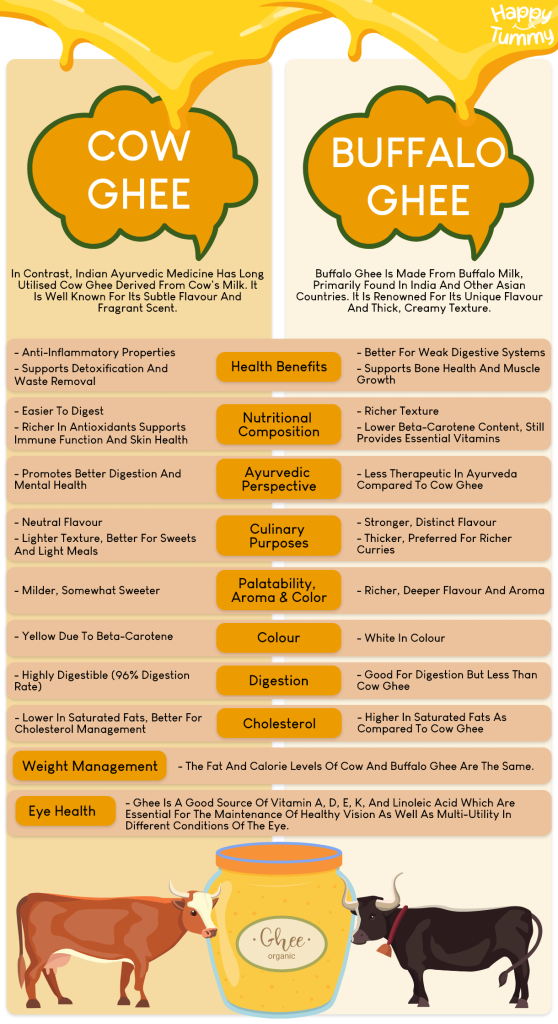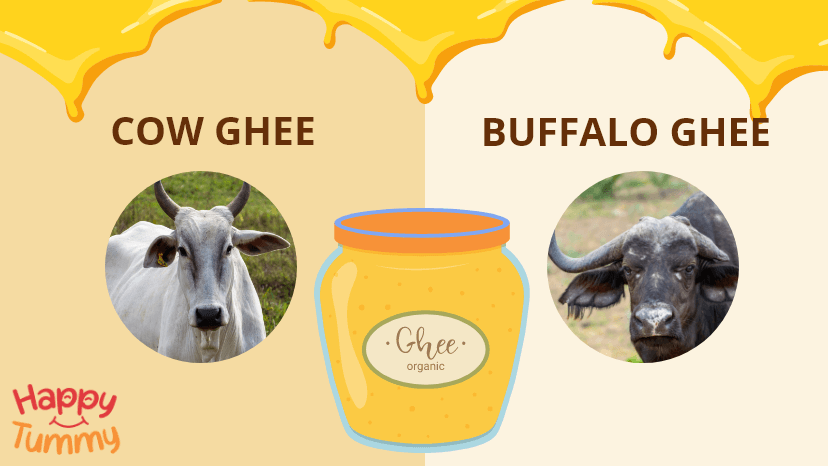Table of Contents
Ghee is a common ingredient in every Indian household. The rich scent of ghee sizzling on the stove evokes pleasant recollections of simpler days.
Grandmothers often shared their wisdom about ghee’s unique qualities.
But have you ever wondered which ghee you consume – cow or buffalo ghee?
What impact does that have on your health? Despite their apparent similarities, the two are clearly different from one another.
Each variety of ghee served a specific function, from complementing meals to calming skin to playing a crucial role in ceremonies.
So continue reading to learn more about Cow Ghee vs. Buffalo Ghee: Which Is Better?
What is Buffalo Ghee?
Buffalo ghee is made from buffalo milk, primarily found in India and other Asian countries. It is renowned for its unique flavour and thick, creamy texture.
Making buffalo ghee involves simmering buffalo milk until the water content evaporates, leaving behind the golden clarified butter.
What is Cow Ghee?
In contrast, Indian Ayurvedic medicine has long utilised cow ghee derived from cow’s milk. It is well known for its subtle flavour and fragrant scent.
Gradually boiling cow’s milk eliminates contaminants and milk particles, producing a clean and nourishing type of clarified butter known as cow ghee.
Cow Ghee vs. Buffalo Ghee

#1 Health Benefits
Cow ghee and buffalo ghee both have several health advantages. Ghee is abundant in antioxidants, including vitamins A, D, E, and K. It may help brain health, boost the immune system, facilitate digestion, and improve nutrient absorption.
As ghee is a rich source of fat, which may help lubricate the intestine and facilitate bowel movements, both cow & buffalo ghee is especially advantageous for people with weak digestive systems.[1]
According to research studies, it is shown that consuming ghee is beneficial for bone health as it helps increase bone mineral density and may reduce the risk of osteoporosis and osteopenia.
Ghee is a good source of Vitamin D which is a vital nutrient for bone health.[2]
Both cow & buffalo ghee comprise various fats, including saturated, monounsaturated, and polyunsaturated fatty acids. These fats provide anti-inflammatory qualities that may assist with managing inflammation.
Free radicals can lead to long-term health issues, but antioxidants found in ghee may help regulate their growth.
Consuming cow ghee regularly may help the body eliminate waste, supporting a safe and effective detoxification process. [3]
Therefore, comparing cow and buffalo ghee, each has advantages. You can eat either one depending on your unique requirements.
#2 Nutritional Compositions
Although they differ somewhat, buffalo and cow ghee have comparable nutritional profiles. Their nutritional profile is as follows:
NUTRITIVE VALUE FOR GHEE[4]
| Nutrients | Cow ghee | Buffalo ghee |
| Energy (kcal) | 900 | 900 |
| Fat (g) | 100 | 100 |
| B-carotene (mcg) | 600 | 270 |
NIN Nutritive value of Indian Food ICMR (book)
Cow ghee is a rich source of energy, providing 900 kcal per 100 grams, and is entirely made up of fat.
It stands out for its healthy fats, particularly unsaturated fats like Monounsaturated Fatty Acids (MUFA) and Polyunsaturated Fatty Acids (PUFA).
These fats are known to support heart health and may help reduce bad cholesterol levels.. [5]
Additionally, cow ghee is richer in beta-carotene (600 mcg), which adds to its health benefits, as beta-carotene is a powerful antioxidant that may support immune function and skin health.
Therefore, while their overall calorie and fat content may be similar, cow ghee provides healthier fats that offer additional health benefits.
#3 Ayurvedic Perspective
Ghee effectively conveys various herbs and spices with various therapeutic qualities to certain parts of the body. For this reason, ghee is used in hundreds of herbal formulations used in Ayurveda to manage various illnesses.
In Ayurveda, cow ghee is said to have higher therapeutic qualities. Cow ghee is recognised as one of the most sattvic foods and is said to promote positivity, growth, and the expansion of consciousness.
According to Ayurveda, cow’s milk is the essence of good energy. Cow ghee may improve digestion and is used in Ayurvedic Nasya treatments for headaches and hair loss.[6]
#4 Culinary Purposes
Ghee is ideal for stir-frying and sautéing due to its high smoke points. However, the distinct flavour components and scents could differ. While buffalo ghee has a distinct flavour that many foodies adore, cow ghee has a more neutral smell.
Cow ghee’s lighter texture makes it ideal for preparing sweets and light meals, while buffalo ghee’s thickness makes it the favoured option for making richer and heavier curries.
#5 Palatability, Aroma & Color
With its subtle sweetness and mild, nutty flavour, cow ghee is perfect for adding flavour to a variety of foods. It has a mild, pleasant scent that provides a soothing feeling.
Meanwhile, buffalo ghee gives dishes depth with its richer, creamier flavour. It leaves an aroma that lasts and is strong and slightly pleasant.
The most significant difference between buffalo and cow ghee is colour. Buffalo ghee is white, but cow ghee is yellow. At first look, they are distinguishable from one another.
Since beta-carotene is a naturally occurring pigment that gives ghee its unique colour, cow ghee’s higher concentration of beta-carotene (600 mcg) than buffalo ghee (270 mcg) helps to offer the ghee’s brighter golden-yellow colour.
#6 Weight Management
The fat and calorie levels of cow and buffalo ghee are the same. If someone is on a calorie-deficit diet or wants to lose weight, they can consume either type of ghee carefully and in moderation to avoid exceeding their daily calorie intake.
Cow ghee has healthy fat and may help with managing weight.[7]
Cow ghee has higher conjugated linoleic acid (CLA) and less fat. CLA may lower the chance of weight gain, increase metabolism, and maintain low insulin levels.[8]
#7 Bone Health
Regarding bone health, both cow and buffalo ghee might help.
Ghee is regarded as a “Rasayana” or a revitalising agent encouraging vitality from an Ayurvedic perspective. Through a variety of processes, ghee may be able to contribute significantly to the promotion of bone and joint health.
Its anti-inflammatory, bone-strengthening, and joint-lubricating qualities are attributed to its high vitamin D, K2, A, and E content, as well as healthy fatty acids like butyrate and CLA.
According to research studies, it is shown that consuming ghee is beneficial for bone health as it helps increase bone mineral density and may reduce the risk of osteoporosis and osteopenia. Ghee is a good source of Vitamin D which is a vital nutrient for bone health.[9]
#8 Digestion
Cow ghee is good for digestion because of its unsaturated fats, such as Monounsaturated Fatty Acids (MUFA) and Polyunsaturated Fatty Acids (PUFA), which may support a healthy gut lining and increase nutrient absorption.[10]
Among all fats obtained from plant or animal sources, cow ghee has the greatest digestion rate, with 96%. [11]
Further, fat in the buffalo ghees is also considered a natural lubricant, facilitating the easy passage of food through the intestines.
Thus, both buffalo and cow ghee are good for digestion because they contain medium-chain fatty acids that make the digestion process easier.[12]
You can occasionally feel perplexed regarding your digestive quotient. However, things get simpler with Aashirvaad Digestive Quotient. Aashirvaad Atta with Multigrains and a team of expert nutritionists, have designed the Digestive Quotient test to check your digestive score out of 100.
Take this two-minute test to determine your Digestive Quotient, then use your scorecard to plan your meals properly and determine whether your road to a Happy Tummy is progressing smoothly.
#9 Cholesterol
Because cow ghee contains more unsaturated fats, especially Monounsaturated Fatty Acids (MUFA) and Polyunsaturated Fatty Acids (PUFA), which are known to raise good HDL cholesterol and decrease bad LDL cholesterol, it may be a good option to manage cholesterol levels. [13]
However, as it is high in calories it is important to consume ghee mindfully and in moderation within the daily calorie limit. as excess calories can cause weight gain and risk of lifestyle disorders.
Cow ghee may be the better choice for people watching their cholesterol because of its heart-healthy fat content.
#10 Eye Health
Ghee is a good source of Vitamin A, D, E, K, and Linoleic acid which are essential for the maintenance of healthy vision as well as multi-utility in different conditions of the eye.
Ghee prevents the oxidative stress of the tissues and helps prevent degenerative diseases including age-related eye diseases.
The antimicrobial activity of ghee is useful in treating inflammatory eye disease as an external application. Since the health of our eyes is closely linked with ghee, it is understandable that ghee most essential for our eyes.[14]
Cow Ghee Vs. Buffalo Ghee
| Aspect | Cow Ghee | Buffalo Ghee |
| Health Benefits | – Anti-inflammatory properties | – Better for weak digestive systems |
| – Supports detoxification and waste removal | – Supports bone health and muscle growth | |
| Nutritional Composition | -Richer in antioxidants supports immune function and skin health | – Lower beta-carotene content, still provides essential vitamins |
| – Easier to digest | – Richer texture | |
| Ayurvedic Perspective | – Promotes better digestion and mental health | – Less therapeutic in Ayurveda compared to cow ghee |
| Culinary Purposes | – Lighter texture, better for sweets and light meals | – Thicker, preferred for richer curries |
| – | – Neutral flavour | – Stronger, distinct flavour |
| Taste & Aroma | – Milder, somewhat sweeter | – Richer, deeper flavour and aroma |
| Colour | – Yellow due to beta-carotene | – White in colour |
| Digestion | – Highly digestible (96% digestion rate) | – Good for digestion but less than cow ghee |
| Cholesterol | – Lower in saturated fats, better for cholesterol management | – Higher in saturated fats as compared to cow ghee |
If you want high-quality ghee, choose AASHIRVAAD Svasti Ghee. It is prepared using the unique ‘SloCook’ method, which cooks the ghee slowly for around three and a half hours, intensifying its natural aroma.
You may now use AASHIRVAAD Svasti Ghee to make your favourite delicious recipes and enjoy its remarkable flavours and aromas.
Long Story Short…
Ghee or clarified butter is a good source of healthy fats and is recommended in moderation for improving overall health. Although ghee is made similarly, cow and buffalo ghee each offer unique benefits. Cow ghee is yellow, whereas buffalo ghee is white.
Buffalo ghee and cow ghee are identical in terms of health features because they contain similar types of fats. However, what ghee is ideal for you will depend on your current health objectives.
Despite these promising properties, it is important to approach ghee consumption in moderation. It is important to balance ghee consumption with other healthy eating practices.
Contact our certified nutritionist for a personalised 45-minute consultation to determine which type of ghee is best suited for your health needs.
Get expert advice on the nutritional benefits and choose the right ghee for your diet. Schedule your consultation today for a tailored approach to your well-being!
Frequently Asked Questions
Both cow and buffalo ghee are easier on the stomach. It is a good choice for people with sensitive stomachs because of its reduced unsaturated fat level and more considerable amount of medium-chain fatty acids, which make it friendlier to the digestive system.
Buffalo ghee is white and creamier in texture, making it appropriate for some culinary applications. Cow ghee is easily distinguished by its yellowish tint, which is due to the presence of beta-carotene, a precursor of vitamin.
Both cow and buffalo ghee are the healthiest and most adaptable types of cooking fats. Their richer and heavier texture is better suited for curries where a more profound richness and flavour is desired.
















